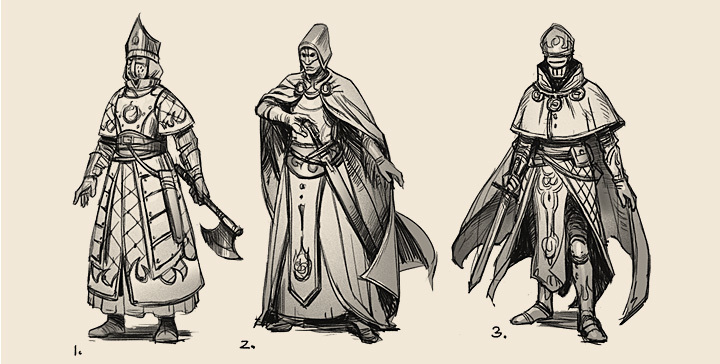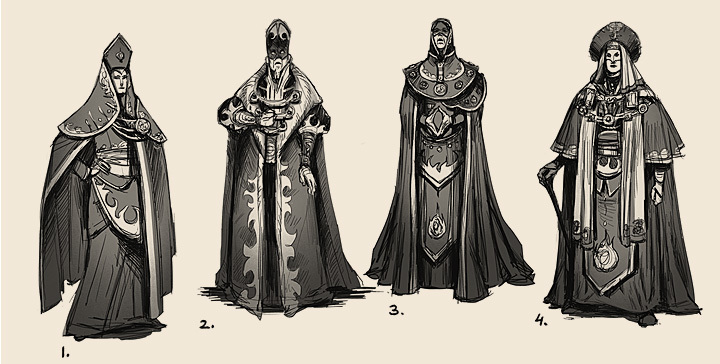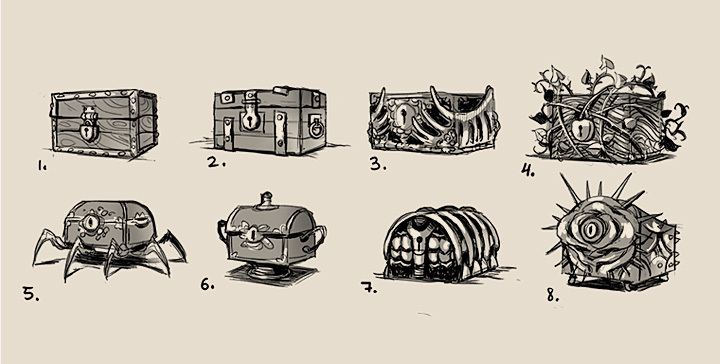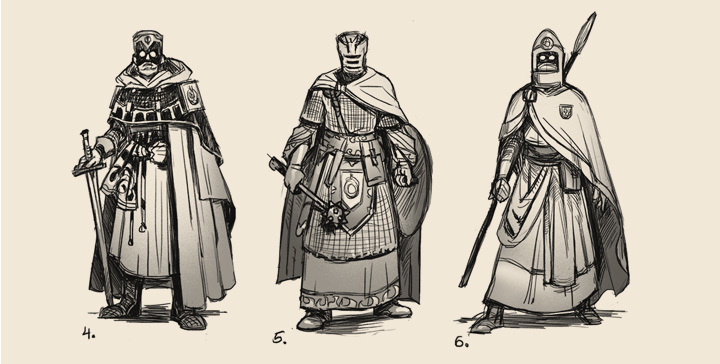#13 – THE CATACLYSM

ːsummer_magicː OTHER ISSUES OF THIS BLOG
ːQuestionsː CONSOLIDATED Q&A THREAD
In this week’s blog, we’re going to look at the events that preceded the rise of the current Empire and its loyal ally Inquisition: what sort of world has existed before the Cataclysm?
THE AGE OF MAGES
For thousands of years, the known habitable lands were the playground of the Great Mages. Each of these mages ruled their domain like a kingdom of its own, with vastly different laws and customs. With almost unlimited magic energy at their hands, they all focused on one thing they loved the most: creation.
Depending on the personal taste of a specific mage, you could find yourself in heaven – or in hell. And since these highly talented, powerful individuals were also very competitive, they would often engage in creating new creatures or structures not only because they wanted to see their own blueprint come through, but also to outdo their rivals in how magnificent their creations would be when compared to others.
When one mage would erect a Spire of Ice, another would soon beat her with the Spire of Fire, only to be looked down upon by the creator of the Spire of Chaos. When one mage would let into the world a new race that would treat him like their god, the other would breed a race that would go further in their worship, sacrificing their young at the gates of her Spire – impressive for a while, but only until the day when yet another mage would cast beings that needed their creator for their very existence, and would wane and die if denied the chance to see their master for prolonged time.
The Great Mages would often engage in creating new types of dwellers and animals not only because they wanted to see their own blueprint come through, but also to outdo their rivals in how magnificent their creations would be when compared to others.
THE STAKES GO UP
As the Great Mages dived into the depths of world on their path of discovery, inevitably they had to interact with each other, whether for partnership – where several mages would exchange valuable knowledge in order to advance each other’s progress; or for rivalry –where several mages would come into direct competition for a particular resource or land.
This led to establishment of the first known Councils, where groups of mages would coordinate their efforts, trading off their previously complete independence for a more powerful position of the whole group. This time is known as The Time of Diplomacy.
Alas, some hundreds of years later the diplomacy of the Councils proved to be insufficient as the local conflicts escalated. The more ambitious the Great Mages became in their endeavors, the more magic energy their projects required, and all magic energy came from the same place: the prehistoric Sources, scattered across the land.
Earlier on, you could locate and claim a Source as your own. Later, with every Source in the known lands accounted for, you had little choice if you wanted to expand: you either had to send an expedition beyond the White Peaks or across the Great Ocean – or you had to take over another mage’s Source, based on cunning and, more often, pure force. This time is known as The Time of War.
Finally, the local conflicts flared up to the degree where deals were made between the strongest of the mages to form two super-powers, known as Alliances, that stretched across all of the continent. Where one powerful mage would be able to forcefully appropriate a part of her neighbor’s land, an Alliance wielded the power that could completely wipe out a selected domain and its ruler.
With this change, another shift occurred: all of the ongoing research of Great Mages began to focus exclusively on battle magic, with elaborate defenses and all-piercing attack capabilities consuming the entire pool of their magic energy. Consequently, as the result of this great arms race, local conflicts froze, since the risk of the retaliation for any small act of aggression became too big to gamble with. This time is known as The Time of Peace.
Each of the Great Mages ruled their domain like a kingdom of its own, with vastly different laws and customs.
THE CATACLYSM
This quiet period before the storm lasted for nearly 100 years. The earlier formation of the two Alliances speeded up everyone’s progress – as long as a specific discipline lent advantage in attack or defense, it’s been prioritized over pretty much everything else.
Generally, the Great Mages focused on three big areas: their capacity to inflict harm on others; their ability to defend from a threat posed by others; and, finally, the destructive potential of their “last gift”: a curse that would be unleashed immediately after the mage is dead (whether from a deliberate attack, or poisoning, or purely by accident, did not really matter).
Unfortunately for the world at large, most mages progressed the furthest with their attack capabilities, as well as with increasing the power of their death curses, for they believed that the shortest path to efficient defense lies through increasing the risks for the attacker. After a hundred years of this arms race, it was only a matter of time when some random event would trigger the chain reaction of mutual destruction…
Up to date, no one really knows what caused the deadly magic storms and eruptions that are referred to by the survivors as The Cataclysm. What we know, however, is that at some point one of the Great Mages must have been attacked, and with their death, the curse that she created as an insurance against just such an attack, consumed both the attacker and the victim’s domains. Within seconds, the whole world was burning, as simple folks sought refuge as far as possible from the densely populated areas, which became death traps.
After the Cataclysm, those who did not perish in the flames often died of hunger and sickness – or fell prey to more aggressive survivors.
THE SURVIVORS AND THE EMPIRE
As the ash settled upon the land and the screams of the dying subsided, the world found itself heavily wounded. From the Great Mages, none were known to survive. From the thousands of different races of dwellers and creatures brought to life by the Great Mages, only a hundred or so made it through: most were killed in the Cataclysm; some survived the original events but waned in the aftermath, lacking their masters the mages; and some committed collective suicides upon finding themselves godless.
Suddenly, people – the human folk – found themselves as the new masters of the world. Resigned previously to the role of trepid servants, villagers and townsfolk no longer had any standing orders… until the new power emerged: The Empire.
Curiously, the very foundation of the Empire lays in the peculiar interest of one specific Great Mage, who – seeing his neighbors create elaborate creatures – decided that his own path lies in the opposite direction: that of enhancing the power of human-staffed legions, rather than creating alternative races.
Over the generations, his research resulted in advanced spells and rituals that would lend his legions incredible defensive and attacking capabilities, as well as increase the speed of their travel across the land. And it was one of these legions, that managed to survive almost intact through The Cataclysm.
With distress and misery all over the place, the legion galvanized around itself a sphere of relative stability. In the time of suffering, they offered a chance of healing. In the time of chaos, they offered some protection. And so, with time, their camp became the capital of the new state: The Empire. As the Empire drew in more recruits, it started to expand, taking over surviving towns and their lords – and slaying whatever non-human dwellers they would come across, in the process.
During the Cataclysm, a large area in the east became drastically different from the rest of the world – and stayed that way. This area is known as The Distorted Lands.
ACROSS THE OCEAN AND BEYOND THE MOUNTAINS...
Lastly, we must address the matter of the lands that may (or may not) lie across the Great Ocean and beyond the White Peaks. By now, you are already familiar with the official point of view, which states that no survivors are known to have come from these regions, hence no survivors must exist there.
In the recent months, there seems to be a bit of a disagreement about this between the Inquisition and the Empire: while the Empire refuses to spend any resources on the exploration of the faraway lands, treating the idea as a pointless, and even harmful, speculation, the Inquisition is becoming more and more concerned with the prospect of a possible unchecked threat that these lands may pose.
Some of the oldest books seem to imply that in the Age of Mages, there used to be a regular telepathic connection between the mages in the land where the current Empire stretches; and the mages from what was called “the other lands”. But for what it’s worth, there’s currently no way to confirm or deny this.
After a long deliberation, some years ago the Inquisition finally sent three ships across the ocean, under the pretext of exploring the Western Coast (populated by the barbarian tribes). Nobody, and no word, has come back…
–––

ːsummer_magicː Official Discord server
ːsummer_magicː Twitter (game updates)
ːsummer_magicː Facebook (game updates)

ːmaliceː Official Discord server
ːmaliceː Twitter (game updates)
ːmaliceː Facebook (game updates)
ːmusicː Original Soundtrack on Spotify

ːnotebookː Twitter (studio news)
ːnotebookː Facebook (studio news)
ːhypnoheartː "Behind the scenes" Instagram
ːfireappleː YouTube

 Illustration 1: When casting a spell or performing a ritual, a mage opens the gates from the plane of the real world to the plane of Chaos, becoming a conductor between the two.
Illustration 1: When casting a spell or performing a ritual, a mage opens the gates from the plane of the real world to the plane of Chaos, becoming a conductor between the two. Illustration 2: Magic talent is not limited to any social or ethnic group.
Illustration 2: Magic talent is not limited to any social or ethnic group. Illustration 3: Two (of the many) colour concepts of drowners, created to hunt, fish and harvest the swamps.
Illustration 3: Two (of the many) colour concepts of drowners, created to hunt, fish and harvest the swamps. Illustration 4: Some of these creatures will become your friends, while others will cause considerable problems for your exploratory parties.
Illustration 4: Some of these creatures will become your friends, while others will cause considerable problems for your exploratory parties.
 Illustration 1: "The Lay of the Land" (a drawing by your disciple Mizegul, whose corpse is currently in the Treasure – awaiting the time when you learn how to bring dead to life).
Illustration 1: "The Lay of the Land" (a drawing by your disciple Mizegul, whose corpse is currently in the Treasure – awaiting the time when you learn how to bring dead to life). Illustration 2: A typical village at the edge of the Empire. People are mostly occupied with their own survival, with little time to spare to be curious about the world outside.
Illustration 2: A typical village at the edge of the Empire. People are mostly occupied with their own survival, with little time to spare to be curious about the world outside. Illustration 3: The Distorted Lands defy description – for in the regular world, there's simply nothing similar to compare them to.
Illustration 3: The Distorted Lands defy description – for in the regular world, there's simply nothing similar to compare them to. Illustration 4: The Inquisition is organised into different ranks, from the simple soldier monks and up to the members of the Council.
Illustration 4: The Inquisition is organised into different ranks, from the simple soldier monks and up to the members of the Council.
 Illustration 1: Mushroom-eaters.
Illustration 1: Mushroom-eaters. Illustration 2: Bone Creatures.
Illustration 2: Bone Creatures. Illustration 3: Fluter.
Illustration 3: Fluter. Illustration 4: Drowners.
Illustration 4: Drowners. Illustration 5: The Many-Handed.
Illustration 5: The Many-Handed. Illustration 6: Stingtails.
Illustration 6: Stingtails. Illustration 7: Cyclops.
Illustration 7: Cyclops. Illustration 8: Pale Ones.
Illustration 8: Pale Ones.
 Illustration 1: Concepts for the mid-level members of the Inquisition.
Illustration 1: Concepts for the mid-level members of the Inquisition. Illustration 2: Concepts for the high-ranking members of the Inquisition.
Illustration 2: Concepts for the high-ranking members of the Inquisition. Illustration 3: Concepts for various chests (located in different locations, originally owned by different types of creatures).
Illustration 3: Concepts for various chests (located in different locations, originally owned by different types of creatures). Illustration 4: Concepts for the mid-level members of the Inquisition.
Illustration 4: Concepts for the mid-level members of the Inquisition.